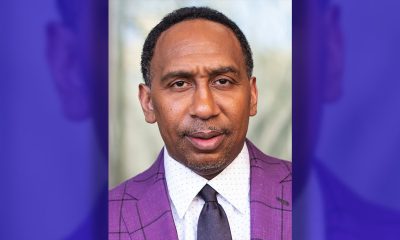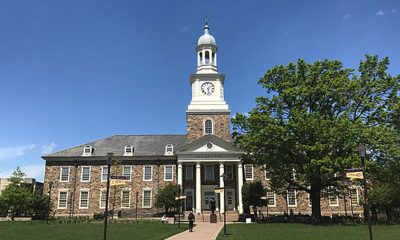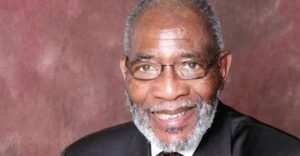Black History
Know Your History, Know Yourself
MILWAUKEE COURIER — Black History Month is about many things, but above all it is about honoring and recognizing those who came before us.
By Alderman Ashanti Hamilton, Common Council President City of Milwaukee
Black History Month is about many things, but above all it is about honoring and recognizing those who came before us: our ancestors. It is about looking at our ancestors, our elders and the generations to come who will radically change the world. We read biographies, listen to speeches, look at photos and do a host of other activities to briefly acknowledge the impact that Blacks of African descent have had on the world. During these times, it reminds me of one of my personal heroes who set the standard for how we engage with the important practice of acknowledging Black History, Dr. Carter G. Woodson.
Dr. Woodson was the first person to proclaim the importance of tracking and analyzing the contributions of Black people throughout history. After graduating from Berea College, University of Chicago and Harvard University, Dr. Woodson established the Association for the Study of Negro Life and History. The expressed purpose of this organization was to legitimize Black history as a field of study and recognize Black Americans and their history as an integral part of the country’s story. In reality, Dr. Woodson was the father of Black History itself, in addition to the concept of Black History Month.
Knowing who you are and where you come from is a foundational piece of having value in yourself and your community. What are the historical contributions of people that look like you? What historical events can you take pride in? What can you be proud of as a member of the Black community? Dr. Woodson wanted to institutionalize the answers to these questions. He wanted everyone to be educated in a way that made this history a known and understood part of the historical fabric of the nation–not just a unit taught in a history class or a few reading assignments during February. The goal was always to have the broader community learn the realities of our history, not just the people who knew it through experience.
This is so important when we talk today about changing the narrative in Milwaukee. If people understand our history and are taught the ways that our systems and mainstream discussions mischaracterize and omit the contributions of Black people throughout history, then they are less likely to internalize this false narrative. Our community is so much more than being enslaved and fighting for civil rights, yet that is too often the simplistic perception of our history. To change the narrative of our community, we must educate the masses about the greatness of our history, proclaim the greatness of our history and live up to the greatness of our history. This begins with the practice of documenting and studying the history of Black Americans that Dr. Woodson pioneered.
Another remarkable thing about Dr. Woodson was that he radically changed life for Black Americans in such a unique and sometimes forgotten way. His purpose and life’s mission was educating people. He was imparting knowledge on them that they would not get from anyone else. And he was doing this in the 1920s, only a few decades after the legal emancipation of slaves. To honor his legacy, we must be intentional about educating people in the same way.
One of the reasons that I became an educator was that I had teachers and mentors in my life that were intentional about sharing this history with me. I had people who would not let me accept and internalize mainstream perceptions of me and my ancestors. Gaining that knowledge transformed the value I placed on my own life and the lives of those around me. I felt then and still feel obligated to pay that forward and educate future generations to understand their history in a more powerful context.
As I think about the number of books, essays and other writings that Dr. Woodson published, I immediately think of a passage from his seminal work, The Miseducation of the Negro:
Philosophers have long conceded, however, that every man has two educators: that which is given to him and that which he gives himself. Of the two kinds, the latter is by far the more desirable. Indeed, all that is most worthy in a man he must work out and conquer for himself. It is that which constitutes our real and best nourishment. What we are merely taught seldom nourishes the mind like that we teach ourselves.
This passage is a transformational piece for any member of our community to read and is just a drop in the ocean of publications and works that have are available to bring our history to life. We can read books like the Souls of Black Folk, I am Not Your Negro and The Autobiography of Malcolm X. We can go to the Wisconsin Black Historical Society Museum, America’s Black Holocaust Museum and the National African American History and Cultural Museum. We can talk to our elders and gain knowledge through the rich oral history that they can share. These are opportunities to learn some of these would not have existed without Dr. Woodson and we owe it to his legacy to take advantage.
My call to us today is to use this month as an opportunity to engage with our history in an intentional way now and every day for the rest of our lives. More importantly, we need to teach our children this history from a young age and never allow them to doubt their value and greatness. As a community, we have so much to take pride in. Let’s learn about this history – because in doing so we learn about ourselves.
This article originally appeared in the Milwaukee Courier.
Activism
Oakland Post: Week of November 26 – December 2, 2025
The printed Weekly Edition of the Oakland Post: Week of November 26 – December 2, 2025
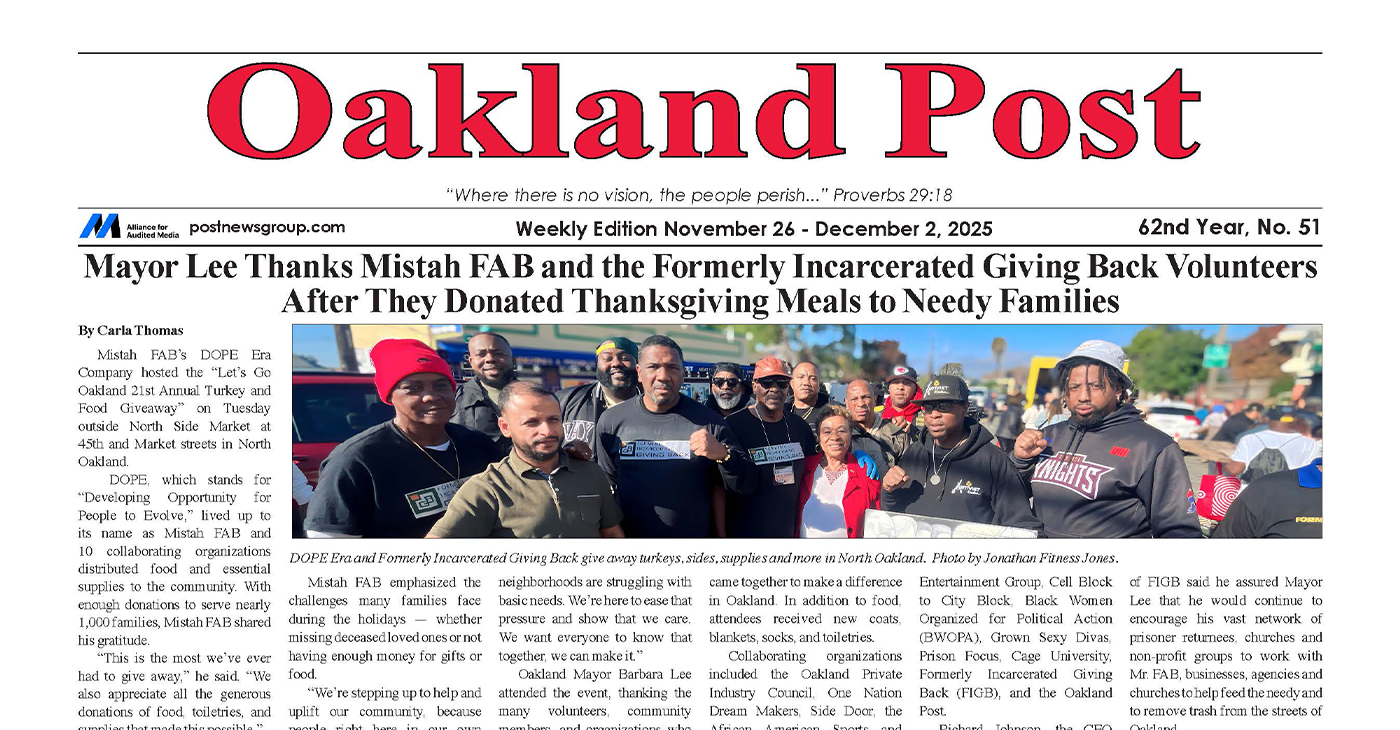
To enlarge your view of this issue, use the slider, magnifying glass icon or full page icon in the lower right corner of the browser window.
Activism
Oakland Post: Week of November 19 – 25, 2025
The printed Weekly Edition of the Oakland Post: Week of November 19 – 25, 2025
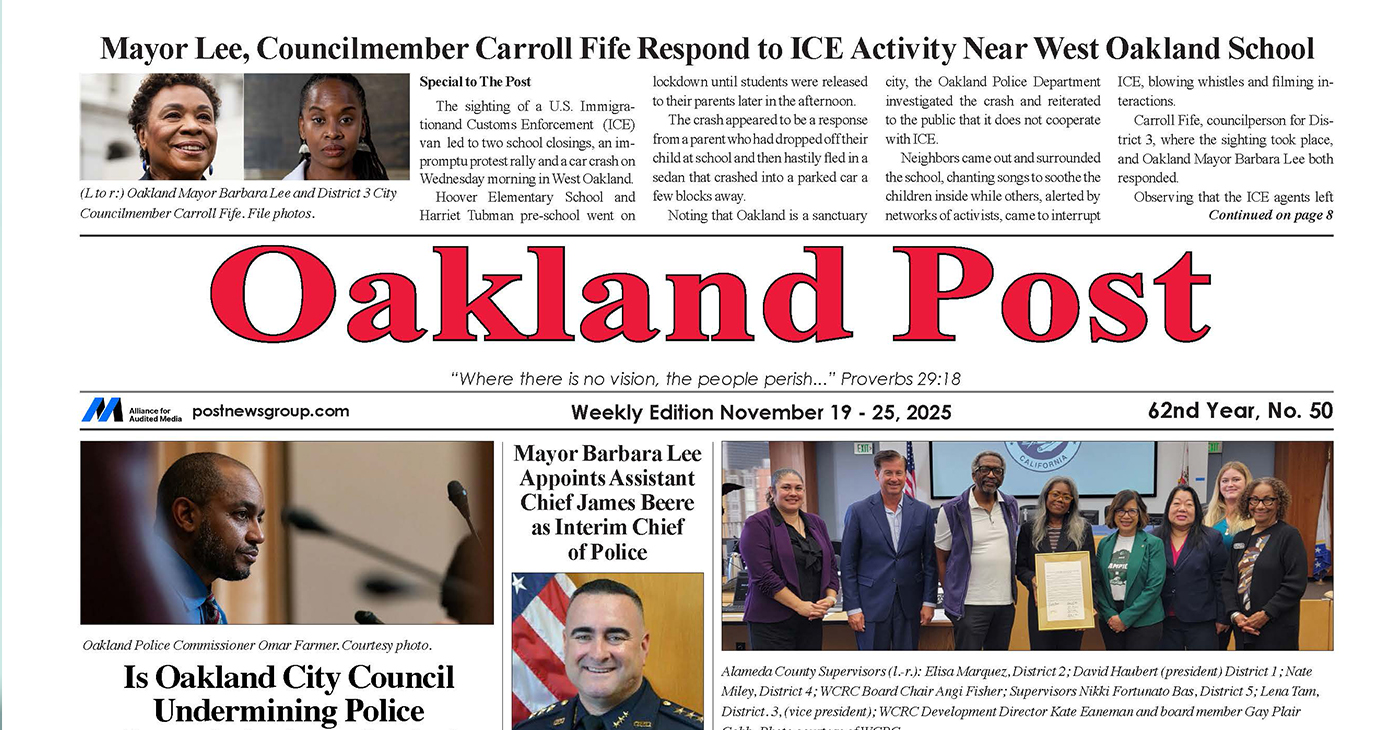
To enlarge your view of this issue, use the slider, magnifying glass icon or full page icon in the lower right corner of the browser window.
Activism
IN MEMORIAM: William ‘Bill’ Patterson, 94
Bill devoted his life to public service and education. In 1971, he became the founding director for the Peralta Community College Foundation, he also became an administrator for Oakland Parks and Recreation overseeing 23 recreation centers, the Oakland Zoo, Children’s Fairyland, Lake Merritt, and the Henry J. Kaiser Convention Center.
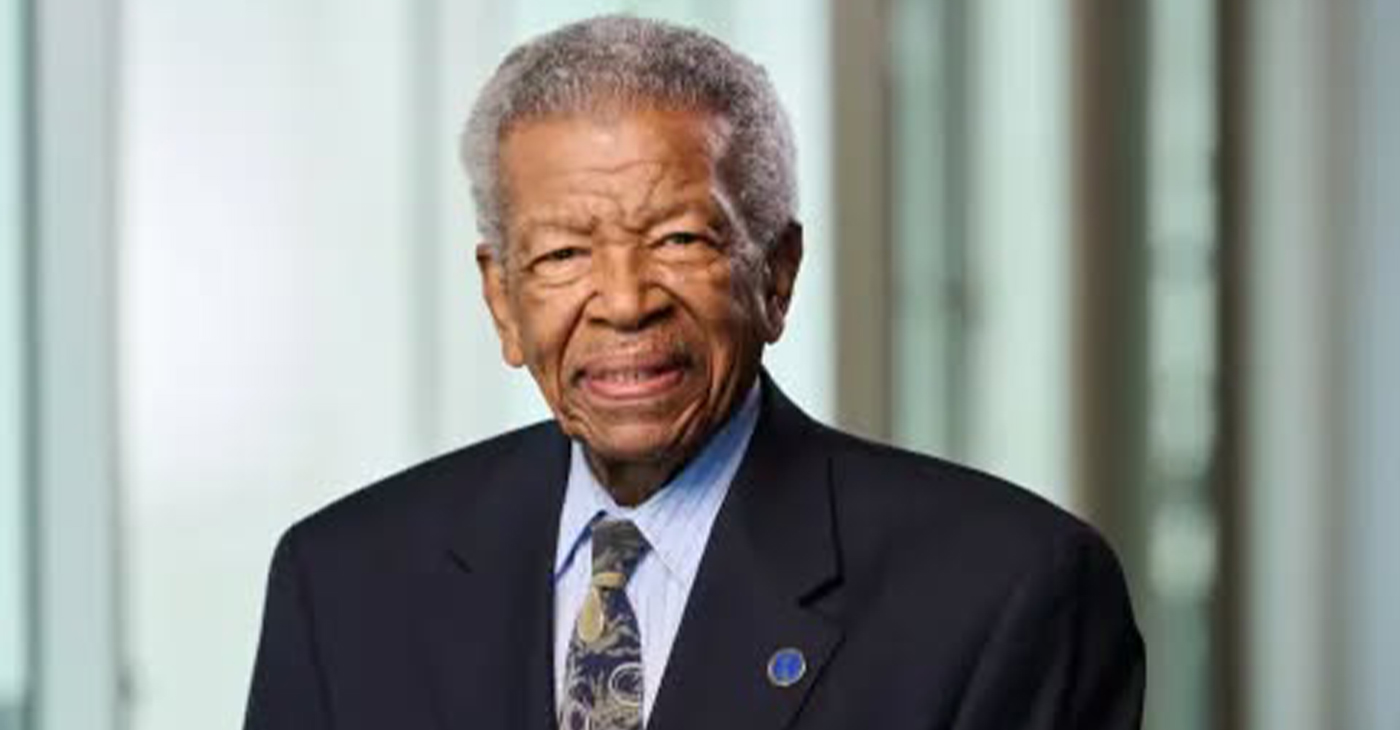
William “Bill” Patterson, 94, of Little Rock, Arkansas, passed away peacefully on October 21, 2025, at his home in Oakland, CA. He was born on May 19, 1931, to Marie Childress Patterson and William Benjamin Patterson in Little Rock, Arkansas. He graduated from Dunbar High School and traveled to Oakland, California, in 1948. William Patterson graduated from San Francisco State University, earning both graduate and undergraduate degrees. He married Euradell “Dell” Patterson in 1961. Bill lovingly took care of his wife, Dell, until she died in 2020.
Bill devoted his life to public service and education. In 1971, he became the founding director for the Peralta Community College Foundation, he also became an administrator for Oakland Parks and Recreation overseeing 23 recreation centers, the Oakland Zoo, Children’s Fairyland, Lake Merritt, and the Henry J. Kaiser Convention Center.
He served on the boards of Oakland’s Urban Strategies Council, the Oakland Public Ethics Commission, and the Oakland Workforce Development Board.
He was a three-term president of the Oakland branch of the NAACP.
Bill was initiated in the Gamma Alpha chapter of Kappa Alpha Psi Fraternity.
In 1997 Bill was appointed to the East Bay Utility District Board of Directors. William Patterson was the first African American Board President and served the board for 27 years.
Bill’s impact reached far beyond his various important and impactful positions.
Bill mentored politicians, athletes and young people. Among those he mentored and advised are legends Joe Morgan, Bill Russell, Frank Robinson, Curt Flood, and Lionel Wilson to name a few.
He is survived by his son, William David Patterson, and one sister, Sarah Ann Strickland, and a host of other family members and friends.
A celebration of life service will take place at Henry J. Kaiser Convention Center (Calvin Simmons Theater) on November 21, 2025, at 10 AM.
His services are being livestreamed at: https://www.facebook.com/events/1250167107131991/
In lieu of flowers, donations can be made to the Euradell and William Patterson scholarship fund TBA.
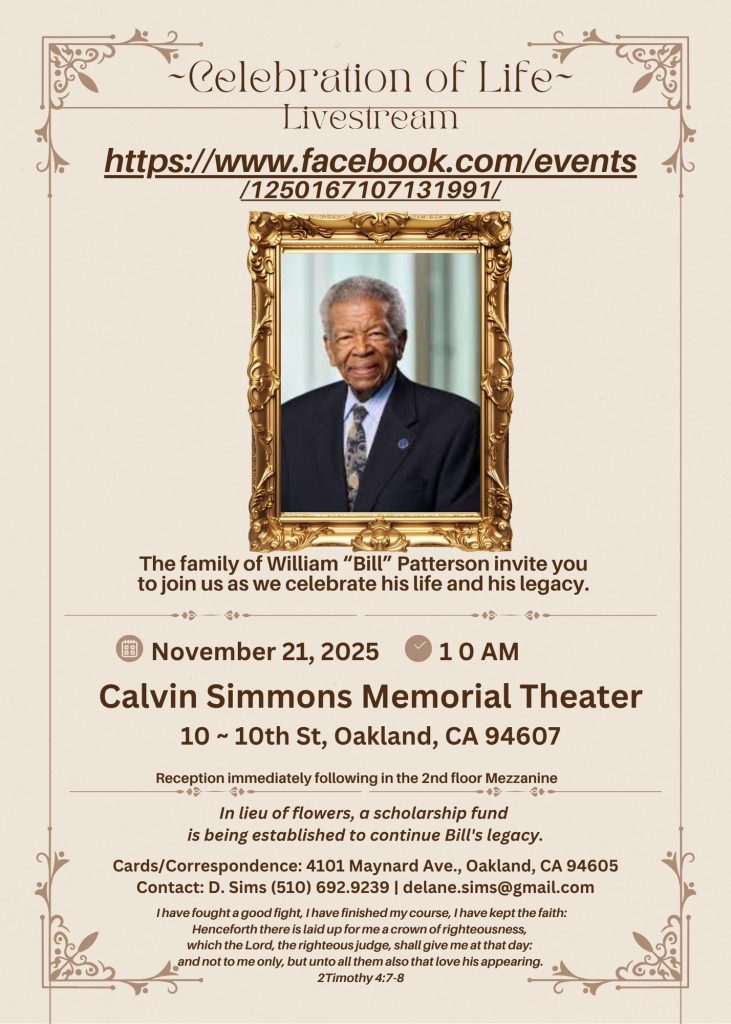
-

 Activism4 weeks ago
Activism4 weeks agoOakland Post: Week of November 12 – 18, 2025
-

 Activism3 weeks ago
Activism3 weeks agoIN MEMORIAM: William ‘Bill’ Patterson, 94
-

 Activism4 weeks ago
Activism4 weeks agoHow Charles R. Drew University Navigated More Than $20 Million in Fed Cuts – Still Prioritizing Students and Community Health
-

 Bay Area4 weeks ago
Bay Area4 weeks agoNo Justice in the Justice System
-

 #NNPA BlackPress3 weeks ago
#NNPA BlackPress3 weeks agoLewis Hamilton set to start LAST in Saturday Night’s Las Vegas Grand Prix
-

 #NNPA BlackPress3 weeks ago
#NNPA BlackPress3 weeks agoBeyoncé and Jay-Z make rare public appearance with Lewis Hamilton at Las Vegas Grand Prix
-

 Activism3 weeks ago
Activism3 weeks agoOakland Post: Week of November 19 – 25, 2025
-

 #NNPA BlackPress4 weeks ago
#NNPA BlackPress4 weeks agoProtecting Pedophiles: The GOP’s Warped Crusade Against Its Own Lies


